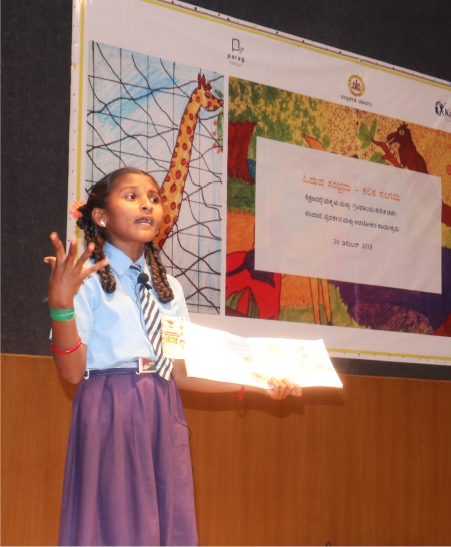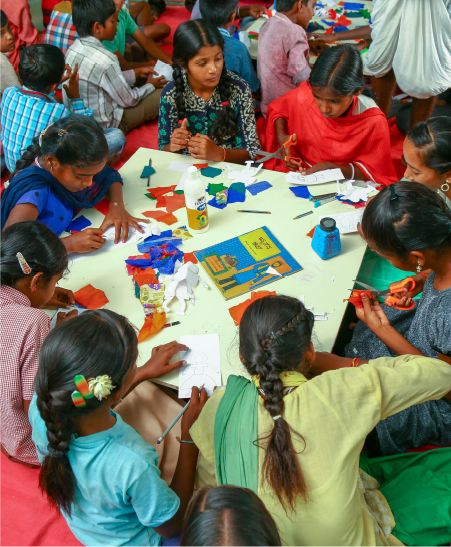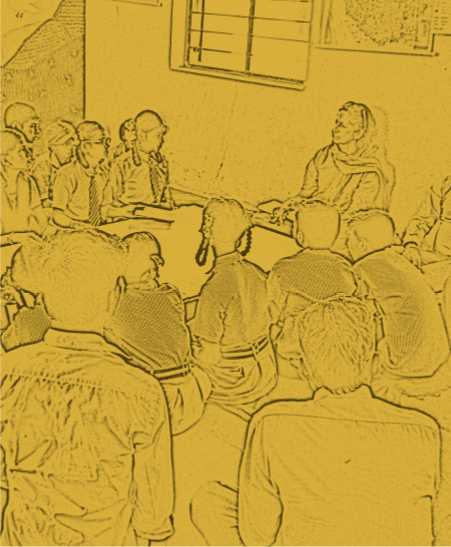
Nali Kali
We work on all links in the chain and begin with Nali-Kali for grades 1 to 3. This was a successful year for this intervention with the following key highlights -
- Orientations for headmasters, Cluster Resource Persons (CRPs), Block Resource Persons (BRPs), Block Resource Centre Coordinators (BRCs), Block Education Officer (BEO), 169 teachers and 23 cluster schools
- Enrolment drives and rallies, both independently and in collaboration with the departments, lead to accelerated attendance in schools
- Teaching learning material workshop for 67 Nali-Kali teachers to enhance the pedagogy
- 74% Nali-Kali teacher participation at Cluster-level Meetings in 23 clusters
- Infrastructure and resource material to 23 clusters for setting up model Nali-Kali centres
Learning Improvement Programme (LIP)
Under this initiative we conducted baseline, midline and end-line assessments across 80 centres. The evaluation revealed qualitative insights such as ‘children are more expressive and confident’. Quantitatively 67% secured more than 75% marks thus moving from level 4 to 1; as opposed to 95% of children who secured 25% or less marks during the baseline study. Review cum planning meetings were conducted with 80 animators.
Enhancing Proficiency in English Language (EPEL)
The EPEL initiative facilitates a smooth transition into English fluency, by adopting a methodology driven by content and storytelling. Selected English language teachers underwent Teaching Knowledge Test (TKT) developed by Cambridge English for Speakers of Other Languages (ESOL), and were awarded professional credentials upon completion. The coverage spanned 100 schools including 126 teachers and 14,100 students of which 1,100 students were from grades 1 - 3 and 13,000 were from grades 4 – 8.
Library Programme
The ‘Library’ intervention is entirely unique, and was launched in partnership with the Department of Public Instruction (Education). The idea is powerfully simple - access to quality books so as to encourage reading and hone higher order skills among school children.
The core library activities conducted were (but are not limited to) - read aloud, storytelling, readers’ theatre, book talks, logical and imaginary thinking, free writing, shared reading, role play, painting, craft and creative expression. Most of the schools have formed children library clubs, and are actively involved in library management. An average 19 books are read by children in intensive school and 9 books in extensive school.
Capacity building was facilitated on multiple levels; an external team from IMPACT conducted assessments to develop a baseline for schools facilitating the setup of model libraries. Books and learning materials were distributed, summer scheduling was a big hit to encourage leisurely reading, elders were invited to tell stories and ‘Librarian’s Day’ was widely celebrated attracting fair participation from parents as well.
 A bala-mela in particular made a memorable impact, titled ‘Oduva Sambhram Kalika Sangama’ meaning ‘Joy of Reading – Confluence of Learning’ which took place on 20th December, 2018. We hosted 650 attendees from different walks of life and took the opportunity to share our learning and advance our advocacy of literacy in a positive context. The impact of the intervention was showcased on this special day, celebrated with cultural performances as the 10 best libraries were recognised and given special awards. The success of this event rested on our intensive work strengthening libraries. The District Deputy Commissioner, Mr. Kurma Rao (IAS) inaugurated the event, graced by the presence of esteemed author and thinker - Mr. Nagesh Hegde.
A bala-mela in particular made a memorable impact, titled ‘Oduva Sambhram Kalika Sangama’ meaning ‘Joy of Reading – Confluence of Learning’ which took place on 20th December, 2018. We hosted 650 attendees from different walks of life and took the opportunity to share our learning and advance our advocacy of literacy in a positive context. The impact of the intervention was showcased on this special day, celebrated with cultural performances as the 10 best libraries were recognised and given special awards. The success of this event rested on our intensive work strengthening libraries. The District Deputy Commissioner, Mr. Kurma Rao (IAS) inaugurated the event, graced by the presence of esteemed author and thinker - Mr. Nagesh Hegde.
Kanya Sampoorna
 Kanya Sampoorna is a holistic programme that empowers the girl child through every stage of development. We implemented technology-enabled education and pre-vocational training as part of our innovative education intervention. The pre-vocational training centre is linked to vocational courses of our current skill development interventions. The products created by our students in pre-vocational training centres were put on exhibit at bala-melas and twenty-six students studying in pre-university college were awarded scholarships.
Kanya Sampoorna is a holistic programme that empowers the girl child through every stage of development. We implemented technology-enabled education and pre-vocational training as part of our innovative education intervention. The pre-vocational training centre is linked to vocational courses of our current skill development interventions. The products created by our students in pre-vocational training centres were put on exhibit at bala-melas and twenty-six students studying in pre-university college were awarded scholarships.
Further Kalike’s ‘Adolescent Education Programme’ emerged as a safe space for young women to build resilience and respond to real-life situations responsibly in a positive manner. As part of our ‘Non-formal Education’ intervention, we recruited and trained animators from 17 villages. Two training centres, as part of the “Pre-Vocational program”, continued to impart training on arts, crafts and basic computer skills. Remedial teacher training support activities continued in girls’ hostel and high schools.
Technology enabled and pre-vocational training forms an integral part of the Kanya Sampoorna programme for empowering the girl child
Case Study
 Nagesh, from Keshawar village, was orphaned at a young age and raised by his three older sisters. Surviving hand to mouth Below Poverty Line, Nagesh was hungry to learn. His native language being Telugu, he struggles with English at the Government Primary School in his village. Ms. Shivaleela, the English teacher at the school took note of his difficulty to pronounce words and that he was lagging behind the other students as he was unable to comprehend the language. She took a keen interest, made a home visit and successfully earned the buy-in of his sisters in Nagesh’s education.
Nagesh, from Keshawar village, was orphaned at a young age and raised by his three older sisters. Surviving hand to mouth Below Poverty Line, Nagesh was hungry to learn. His native language being Telugu, he struggles with English at the Government Primary School in his village. Ms. Shivaleela, the English teacher at the school took note of his difficulty to pronounce words and that he was lagging behind the other students as he was unable to comprehend the language. She took a keen interest, made a home visit and successfully earned the buy-in of his sisters in Nagesh’s education.
Together, they worked as a team to ensure he received the right stimulus and opportunity. With special attention and extra time spent on building his foundation, he soon was able to speak basic English and was making progress on his LSRW skills. Today, he completes his homework as soon as he comes home, can read full sentences from text books and is very much at par with his class. Determined, his progress has been impressive so much so that even his Head Teacher Mr. Devya Rathod has remarked on this achievement, and graciously thanks Kalike’s Proficiency in English programme for this success story. For Nagesh, education and the English language will spell the difference between comfort and poverty.
